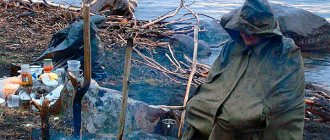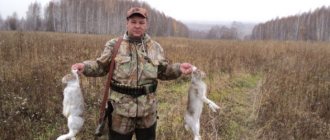Our ancestors created many folk tales about the weather, which we continue to use to this day. Moreover, even without any special devices and devices, our grandparents could make a fairly detailed and accurate forecast.
Today, these weather predictions have not lost their popularity: using folk signs associated with the behavior of animals and plants, one can predict what nature has in store for us several months in advance.
How to predict the weather?
There are general signs about the weather that can provide the following forecast:
- There is fog in the morning - there will not be a cloud in the sky during the day;
- on a sunny day the sky pours rain on the earth - expect rain tomorrow too;
- the clouds are painted in different shades - the weather will change;
- the main color of the rainbow is green – rain is expected, yellow – clear days, red – heat and wind;
- dewdrops rest on the very tips of the grass - the clouds will pour rain;
- the chestnut foliage is covered with sticky drops - the rain will wash them in about a day;
- the ponds suddenly became dark - there will be a thunderstorm soon;
- Frequent rumbles of thunder are heard that look like a roar - expect hail;
- we saw a ring around the moon - towards the wind;
- It’s dry outside and the trees are losing branches - signs say that it will rain soon;
- the sky is overcast with thunderclouds, but the bees continue to fly - no precipitation is expected;
- the beetles are buzzing loudly - the sky will be clear and the day will be warm;
- noticed a rainbow in the early morning - the weather will deteriorate, but if in the evening it will be clear;
- small drops of rain indicate that the bad weather will drag on;
- dew has abundantly covered the grass - the day will turn out to be beautiful and hot;
- dewdrops on the foliage in thick fog - the sky will be clear;
- green rays at sunset - good weather is expected for tomorrow;
- clouds rise higher and higher - signs promise improved weather conditions;
- the wind blows from the northwest - it will bring changeable weather;
- in the morning, after the sun has already risen, the clouds have cleared - the weather is expected to be good;
- the sun rises and lights up the morning sky red - get ready for rain;
- sunset orange - for good weather, red or bright yellow - for windy weather, pale yellow
- or purple - for rainy, pink - for clear;
- clouds float quickly, easily, ahead of the clouds - wind is expected, rain is possible;
- clouds become denser - towards rain, large clouds dissipate - the sky will clear up soon;
- the sky darkens - it will be dry, brightens, becomes whitish - precipitation.
Some folk signs help to form an idea of the upcoming weather by month. For example, if from the fifth to the seventh of April it is mostly windy, then rain is expected in June. Snow fell in the first or second month of autumn - spring will be early.
Signs about sunrise
- If the rising sun is covered by clouds and its rays from the clouds go upward - a sign of rain; from the middle - a storm with a lot of rain.
- A folk sign about the sun: if the rising sun is very bright and the clouds surrounding it have turned red, this portends bad weather for that day, and sometimes rain and wind. Red and black clouds at sunset and sunrise mean rain. (Red clouds before sunrise - to the wind; clouds - to rain; red clouds at sunset - to the bucket and the wind).
- If the sky turns red only at sunrise, it will rain in 1–2 days.
- If at sunrise the sky is painted in all colors, you need to wait for rain that day. (If the sun is red at sunset, it means rain; and if the dawn moves to the south, the weather is good.
- If the dawn is crimson, there will be no rain.
- If the sun is red when the sun rises, it means rain in summer, snow in winter.
- If the sun is red at sunset - to the wind, if the sun rises red - to bad weather).
- If at sunrise the sky remains red for a long time - go to the bucket (it won’t rain soon); if the dawn goes out very soon, it means bad weather (it will rain on the same day). (Before sunrise, the sky is red in the east, and after sunrise the color will disappear - to the rain. The sun is red at sunrise, but immediately discolored - to the rain).
- According to popular weather predictions based on the Sun, if the sky turns red at the very time of sunrise, there will be rain that day, and if it turns red very early, there will be rain at night or the next day.
- If at sunrise, just after dawn, the dawn remains very red, it will rain. (If the evening dawn is very long, it will rain in a day or two, and if it is short, it will rain soon).
- If the sun appears immediately at sunrise and then goes behind a cloud, it will rain that day.
- When the sun at sunrise seems a little more ordinary, you need to wait for rain.
- If the sun rises white, then it will be clear that day and will continue to be clear. The sun, which appears pale at sunset, portends a wind from the west.
Spring
Spring weather signs will tell you how to plan sowing work.
- Larks return home - they bring warmth with them.
- In March, you heard thunder - this is one of the signs of bad weather, so get ready for the cold to return.
- High floating clouds indicate that the day will be fine.
- Snowdrops began to droop and close - signs predict worsening weather conditions; if they bloom, they predict improvement.
- Moles leave their burrows - rain is expected.
By the shade of the sky
When we turn our gaze to the sky, it is important to notice not only its beauty, but also its color. The dark blue color means that the rain will not come soon and you can safely go outside. A whitish sky, on the contrary, will indicate high humidity in the air. Therefore, you should expect heavy rain within 12 hours. Color changes will depend on the atmospheric pressure through which the sun's rays pass and are modified under its influence. In this case, folk predictions work flawlessly.
LHow to find the cardinal directions correctly, read the article: How to determine north and south without a compass day and night
Summer
Summer weather signs will help you plan your vacation.
- The crickets sing loudly - it will be clear and the day is sunny, suddenly they become silent - the sky will give rain.
- Changes in the weather are promised by folk signs associated with frogs: they croak loudly - the day will be clear, quietly - it will be stormy.
- Sparrows are wallowing in puddles - precipitation is expected.
- The wind blows from the west - to worsening weather conditions, from the east - to heat and drought, from the north - it will be very cold in the morning.
- The quiet cooing of pigeons promises a clear, sunny day.
- In the morning you can hear the rumble of thunder - in the evening the clouds burst into summer rain.
- Swallows circle above the ground - signs predict rain.
- During the full moon phase, the sunset is colored red - good weather will last for a long time.
- It’s warm at night - you can hope for a large honey flow.
Weather predictions based on animals
Some animals sense impending changes well. Observing their behavior, people predicted precipitation, an increase or decrease in temperature, and stronger winds. The most famous signs of weather change are:
- Singing crickets signify a clear day, silent crickets signify a cloudy day.
- Loudly croaking frogs heralded a rise in temperature.
- Sparrows swimming in puddles mean rain.
- Quiet cooing of pigeons - the weather will be sunny.
- Hiding sparrows - a thunderstorm is expected in a few hours.
- In winter, a cat sleeps curled up and covering its nose with its paws - to intensify the frost.
By looking at the fur of a hare, you can determine how soon winter or summer will come. If an animal does not change its “clothes” for a long time, it means that heat or cold has not yet arrived.
Autumn
The weather in autumn is judged by the following folk signs.
- Strong wind means a small amount of frost and vice versa.
- At the beginning of autumn, a lot of snow fell - leading to an early and warm spring.
- Rowan produced few berries - to dryness, large clusters - to rain.
- The sun sets and turns the sky pink or yellow - it will be good.
- In September, thunderclaps are heard - according to autumn signs, warm weather will set in.
- Bad weather is predicted by birds perched on the roofs of houses.
Autumn signs can provide weather forecasts for the winter: if mosquitoes are active in late autumn, then the winter months will be relatively warm and mild. There is abundant leaf fall - mostly snowy weather is expected in winter.
Signs about the weather
For the first time, people thought about deciphering natural phenomena long before realizing the very essence of the changes taking place in it. Ancient people were afraid of the violence of the elements, so they remembered the signs of an impending thunderstorm or flood.
It was the observation skills of our ancestors that made it possible to create a whole system of proven signs about the weather. People's knowledge was replenished with new information, which made it possible to avoid misfortune and hunger in a lean year.
The people described the experience acquired over many centuries in folklore. Simple songs and stories had great power because they saved many lives.
80% of people believe in omens
Pundits cannot interpret most folk signs, but the predictions work in almost all cases. For example: birds leave their native lands in autumn, gather in flocks and migrate south. It is difficult to explain this behavior of birds, because the journey to hot countries can cost travelers their lives. This example shows the importance of studying folk signs.
How to predict the weather for the day
Without resorting to the services of the Hydrometeorological Center, it is possible to determine the weather for the coming day by plants, animals and wind direction. Typically, such diagnostics are carried out by summer residents, drivers, flower growers and rural workers.
The most common ways to determine the weather are the following folk signs:
- Darkening at lunchtime means rain in the evening;
- Frost on the trees heralds the coming warmer weather;
- Thunder in the morning means heavy rain in the evening;
- A sunset of delicate pink or yellow color indicates a warm day.
Village residents quite often predict the weather using folk signs, because their future agricultural activities depend on such observations. Residents of megacities and small towns are also advised to pay attention to forecasts that have been confirmed in practice for many centuries.
Winter
The following folk signs will tell you about the weather for the winter.
- Sparrows chirp loudly - there will be a snowstorm.
- Crows are also weather predictors: if they try to hide their beaks under their wings, it means that it will soon be warm, they play on the fly - for good weather, and crows - for precipitation.
- There is not a cloud in the sky - frost is expected.
- There is frost on the trees - it will become warm.
- A cat sharpens its claws on a wooden floor - get ready for a snowstorm.
- In the evenings, the dawns do not burn for long - there will be a thaw.
- Folk signs of winter that predict the weather for other times of the year say: from December to February it is mostly warm - the summer is cold, but if it is frosty - the spring will be warm.
- The stars are bright - the day will be frosty.
- On Paramona (December 12) it is clear in the morning - the weather will be like this all day, it is snowing - snowstorms are expected until December 19, snow is covering the valleys - winter signs promise that snowstorms will last for another week.
- On the Chrysostom Fire (February 9), the clouds began to float against the wind - it will snow.
Popular folk signs
You can find out what the weather will be like in the coming season by referring to popular beliefs. For this, there are special signs about summer, weather in spring, autumn and winter.
To get a long-term forecast, pay attention to ancient folk beliefs.
- If cranes fly south in August, expect early winter. They rise high and quietly let out a cry - autumn will be warm.
- Animals warn about a cold winter if they carry a lot of straw into their burrow.
- The thicker the wild hares, the longer and frostier the winter will be.
- The later spring comes, the longer summer will last.
- The spruce and pine trees produced a poor harvest of cones by warm May.
- The more precipitation falls in November, the faster the cold season will arrive.
- A warm day is indicated by the appearance of dung beetles and the singing of a green grasshopper.
- The more butterflies fly outside when the sky is overcast, the faster the weather will clear up.
Pay attention to the skin of the onions.
- The thinner it is, the warmer the winter will be.
- Thick peel - to severe frosts.
Trees will warn you about the weather in autumn.
- A good rowan harvest portends a lot of rainfall in the fall.
- If the harvest is poor, this time of year will be dry.
- There are a lot of fruits on rowan and oak - expect a frosty winter.
The web will tell you something.
- If there is very little rain, no rain is expected.
- A lot - expect precipitation and warm weather.
Pay attention to the behavior of the squirrels.
- If they store a large supply of nuts for the winter, this time of year will be very frosty.
- The animals settled very low - due to the cold weather.
- The higher the squirrel house, the warmer the winter will be.
Mole is a weather predictor. Depending on which side he blows up the entrance to the house, you can determine the weather in winter.
- From the north, this time of year will be very warm.
- From the south - cold.
- From the east - arid.
- From the west - rainy.
Signs involving plants
Folk signs based on plants can help predict the weather forecast: precipitation, intensity of solar radiation, etc.
- Morning glory has folded its flowers - soon the weather will turn bad, it will rain in a couple of hours.
- The marigolds bloomed early in the morning - the day will be windless, clear and sunny; they unfurled their flowers in the afternoon - a thunderstorm is expected.
- The sign of a bell with well-opened flower stalks promises clear weather, but if they droop, wait for precipitation.
- Water lilies have covered their flowers with leaves - there will be bad weather, if the buds open early in the morning (at 07:00-08:00) and close before 19:00 - a sunny warm day is expected.
- Drops of dew appeared on the leaves of the loosestrife - it will rain in about two hours.
- The nut yielded a rich harvest, but few mushrooms grew - a lot of snow is expected in winter and in general it will be frosty.
- The branches of pines and spruces are rarely covered with cones - there will be little snow in winter, and the days will be warm.
- In the spring, the leaves on the ash tree appeared earlier than on the oak tree - in the summer a large amount of precipitation is expected.
But if the opposite happened: the oak trees were covered with greenery before the ash tree, then the summer will be dry.
- Indoor oxalis has folded its leaves during the day - it will rain soon.
- Weather predictions can also be obtained from folk superstitions about buttercups: if its flowers are open under a cloudy sky, no precipitation is expected.
- The inflorescences on the potato bushes have drooped - bad weather is expected.
- Blooming yellow acacia exudes an intense aroma, and there are many insects above its buds - worsening weather conditions, rain is possible.
- The mountain ash produced flowers later than usual - the autumn will be long and rich in mushroom harvests.
Signs that predict the weather
Folk signs are always based on the centuries-old experience of our ancestors. Usually observations were based on the time of year that people were interested in.
Summer
The interpretation of folk signs about the hot season is quite broad.
The most common versions are:
- Earthworms crawling to the surface means rain;
- Construction of swallow nests on the south side - for a cool summer;
- Getting wet maple leaves means rain;
- Transparent thread-like clouds - to worsening weather conditions;
- Altocumulus clouds - for a sunny and windless day;
- Rare sounds of thunder mean great weather.
Winter
You can also predict the weather for the cold season using folk experience.
Known signs in winter:
- A foggy halo around the sun means a snowstorm cannot be avoided;
- A cloud that has swallowed the sun means a blizzard is to be expected;
- Snowfall with large flakes - slush will ruin your mood;
- Sky without clouds - enjoying a frosty day;
- Sparkling stars - anticipation of frost;
- Loudly chirping sparrows - warming will come soon;
- Chickens sitting on a roost - the frost will make you worry.
Autumn
Folk signs about the autumn season speak volumes.
Ancestral observations predict the following:
- Late flight of birds to the south means late cold weather;
- A squirrel building a nest near the ground means approaching frost;
- A small amount of rowan means a dry spring, a large amount means a rainy season;
- Low clouds - bad weather up to downpour;
- Plenty of nuts with a minimum of mushrooms - a winter full of snow;
- Faintly twinkling stars - it is better to take an umbrella with you;
- Preserved leaves on a cherry tree - cold weather will not come soon;
- Early snowfall in autumn means early spring;
- Migration of geese to the south - there will be snowfall;
- Late mosquito activity - warm winter.
Signs involving animals and birds
Following folk signs about animals and birds, you can also make a weather forecast.
- Hear the chirping of grasshoppers in the rye in the evening - the next day will be sunny.
- Swallows and swallows soar high in the sky in the evening, whistling with their wings and screaming - for good weather, according to folk signs, tomorrow will be a clear and sunny day.
- If dogs swing on the grass, wait for precipitation.
- Birds such as crows and jackdaws cry loudly - it will rain.
- The hen gathers the chicks under her wing - a sharp deterioration in weather conditions is expected: heavy rain, a hurricane is possible.
However, if the chicken stands on one leg, expect cold weather, but no precipitation.
- Rain is promised by frogs that jump restlessly and high near the pond.
- To set up its house, the squirrel climbed high up a tree - this promises a warm, mild winter; if it scurries low, it will be quite cold from December to February.
- Sparrows are floundering in the sand - rain is expected in the evening. If in winter they gather in flocks and scream loudly in flight, it means a snowstorm and a drop in air temperature.
- Swallows, thrushes or finches are circling low - soon the sky will rain.
- The cat sleeps on the floor all day long - warming is coming.
By observing birds, animals, plants and natural phenomena, you can predict weather conditions every day and see that these centuries-old predictions are indeed true.
Signs of bad weather
Impending bad weather throughout the year can be identified by insects. Pay attention to the behavior of ants, dragonflies, and bees.
- The approach of bad weather will be indicated by insects that abruptly fly away from flowers and gather in small groups.
- Bees suddenly swarm over the hive - it means rain.
- If in the fall they behave restlessly and seal the holes in the hive with propolis, this means frost.
- The worse the weather, the deeper the ants get into the home. If they seal all entrances, prepare for bad weather.
- The approach of a thunderstorm is indicated by dragonflies, which rush about randomly and gather in small flocks.
- Fireflies suddenly go out - expect a strong storm.
Pay attention to pest insects
Mosquitoes, gadflies and horseflies become very aggressive when they sense that it will rain soon. They start rushing around and attacking people. This happens because in rainy weather they are unable to move and eat, so they have to eat in advance before the storm.
Take a closer look at the plants
A bad forecast based on folk signs can be made if you pay attention to the behavior of plants. They begin to give signals, foreshadowing bad weather.
- Honeysuckle smells very strongly half an hour before it rains.
- Towards bad weather, calendula unfurls its corollas; The water lily, clover and hollyhock shrink.
- Burdock opens its thorns to the rain.
- If honey and coniferous trees begin to smell very strongly and secrete resin or nectar, this is a sure sign that heavy rain will begin in two hours.
From the history of weather forecasting
21.09.2003 16:02
From ancient times to our time, various myths about the weather have survived, created by the peoples of long-vanished civilizations.
In menacing natural phenomena: volcanic eruptions, flashes of lightning, clap of thunder, hail, tornadoes - our ancestors saw the limitless power of divine forces. When drought destroyed crops over large areas, they called on the gods for help. Myths arose about weather-related miracles. People began to make sacrifices not to the gods, as before, but to wizards who supposedly knew how to “control” the weather. These chosen ones enjoyed divine honors and received many gifts. However, quite quickly people realized that the only protection from bad weather could only be timely preventive measures. For example, the construction of dams to protect against floods, artificial irrigation of fields, etc. And for this it was necessary to learn how to predict the weather.
In those distant times, there was no idea of the difference between the air envelope of the Earth and outer space. It was assumed that the weather could be predicted by the movement of celestial bodies. This is how astrometeorology arose. In the ancient slave society, it was the responsibility of high-ranking officials and heads of state to foretell the weather using the starry sky. During the time of Aristotle in Egypt, priests were charged with predicting not only the weather, but also the prospects for the harvest.
The Chinese emperor, considered the son of heaven, was supposed to inform his people about future celestial events in the annual calendar. For him, the priests prepared special weather forecasts for the year ahead, which were then announced under the name “imperial”. Naturally, it often happened that in these “forecasts” floods, long-term droughts, and a number of other unfavorable phenomena remained unpredicted. The people perceived this as a sign of a quarrel between “heaven” and the emperor. And then the loyal subjects considered it their religious duty to depose the emperor. And the son of “heaven” had no choice but to abdicate the throne, for his priests did not predict the future weather well.
Despite the fact that these predictions were based on completely erroneous ideas about the structure of the atmosphere and the reasons for changes in meteorological conditions, they still persisted for quite a long time and were a step forward compared to “weather myths.”
The need to take care of their safety and their more or less prosperous existence forced people, and above all fishermen, peasants, and sailors, to monitor the state of the weather and water bodies themselves, to try to generalize and accumulate predictive signs of impending bad weather. To do this, first of all, they paid attention to clouds, wind, the color of dawn and sunset, etc. People learned to predict the weather based on the behavior of animals, plants, and birds. For example, strong bites of flies, mosquitoes, a splash of fish on a river or lake were sure signs of impending rain, etc. The idea began to spread that there were days that indicated the weather of the following periods of time.
It was claimed that on Darya's day (February 15) snow always falls, and on Agafya's day (February 6) water will run from the mountains. And if other signs made at least some sense and were sometimes justified in a particular area, then in other places they simply did not make sense. There are many such examples, almost every day.
Some peoples still believe in the “hundred-year weather calendar” to this day. For example, in Germany, a similar calendar went through 200 editions and was translated into a number of other languages. This calendar was extremely easy to use. You just need to establish which planet “rules” a given year, and then read about upcoming events this year.
Methods of weather prediction have changed significantly only since the second half of the 19th century, when meteorologists realized that weather is formed mainly in higher layers of the atmosphere and the study of the entire thickness of the air ocean and the rapid development of the science of meteorology began.










